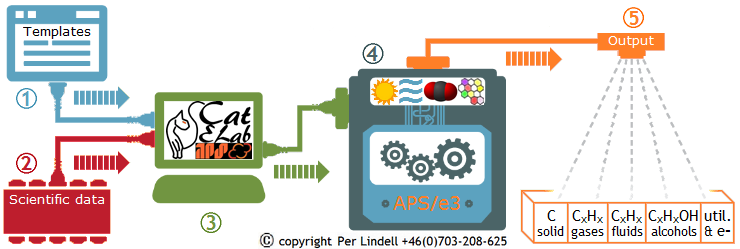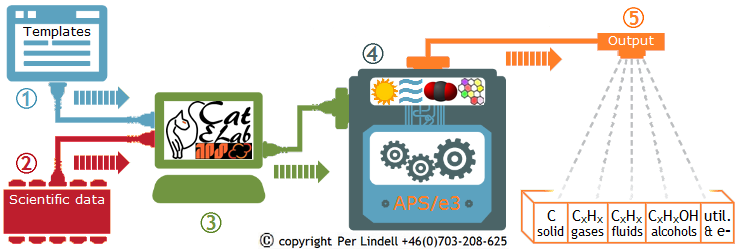| CatELab research software integrated with APS/e3 in iterative, eternal, climate neutral processes:
 » Templates: » Templates:
Algorithms, patterns, rules, (cor)relations, connections, formulae, etc that can be applied on data of various kinds in accordance with scientific facts and research results or other findings based on any field of study. CatELab-APS/e3 imports, utilizes and facilitates formulating new Templates of arbitrary type, usage, and complexity.
 » Scientific data: » Scientific data:
Scientific and any other type of data, stored in the database integrated with CatELab-APS/e3, or extracted from Internet on-the-fly, linked into the Simulator or Template Manager at any level and stage of execution.
 » CatELab-APS/e3 software: » CatELab-APS/e3 software:
The SBES (Simulation Based Engineering Science) “Reactor” for simulating on parameters involving Scientific data (2), Templates (1), temperature, pressure, density, any magnetic field, any electromagnetic radiation, any non catalytic doping or other nano substance, biotic component etc, in order to identify eligible Catalyst candidates to the production of different tailor-made fuels or other products, out of Greenhouse Gases (foremost CO2) in processes based on Applied Artificial PhotoSynthesis (APS). The eligibility of each Catalyst candidate is graded by their conformity to compelling standards constituting (the exchange of) energy, economy and ecology (e3) as an inseparable triangular market frame. The software also manages databases and other datasets, mappings from internet data sources, etc (2), manages Templates (1), and calibrates, measures, evaluates, and controls processes (4), saving every data associated with them along with lab environmental settings.
 » APS/e3 processes: » APS/e3 processes:
APS/e3 processes utilize Applied Artificial PhotoSynthesis, taking the following input: Sunlight, (ocean) Water, (atmospheric or smokestack) Carbon-dioxide, Catalyst(s). Resulting process outputs are fuels and other products.
 » Output: » Output:
• Pure, solid Coal (C) for power plants and industries.
• Gaseous Hydrocarbons (CxHx) like Methane, Ethane, Propane, and Buthane.
• Liquid Hydrocarbons (CxHx) like Hexane, Benzene, Kerosene/Paraffin, and heavier compounds.
Petrol/Gasoline is a mixture of some fifty molecular compounds, Diesel contains heavier molecules.
• Fluid alcohols like Methanol, Ethanol, Propanol, and bi-alcoholic compounds like DME(gaseous) and heavier, liquid ones.
• Utilitarian products like plastics, medicals, fertilizers, building and other construction materials, polymers, waxes, mascaras, lubricating oils, tar, tarmac, and much more. Even electricity could be produced as a bi-product of some processes. Pure Hydrogen (H2) is easily produced splitting (ocean) water through electrolysis (oxidation/reduction) without any catalyst, perhaps best propelled by wind or solar power electricity. However, Hydrogen is not very suitable as a fuel other than in power plants or industries directly adjacent to where it is produced.
|




7 thoughts on “CatELab & APS/e3 integrated processes”